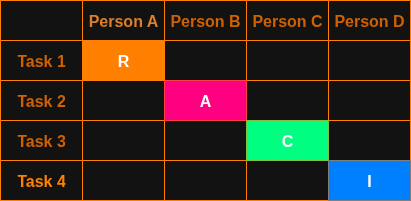I. Overview
What is Responsibility assignment matrix and how it works.
II. Getting Started
Definition: In business and project management, a responsibility assignment matrix (RAM) aka RACI matrix is a model that describe the participation by various roles in completing tasks or deliverables for a project or business.
RACI stands for:
- responsible
- accountable
- consulted
- informed
Key Responsibility Roles in The RACI Model
Role Distinction
There is a distinction between a role and individually indentified people:
a role is a descriptor of an associated set of tasks; maybe performed by many people; and one person can perform many roles.
R = Responsible (also recommender)
- Those who complete the task. There is at least one role with a participation type of responsible, although others can be delegated to assist in the work required.
- Summary: The person who performs the work.
A = Accountable (also approver or final approving authority)
- The one ultimately answerable for the correct and thorough completion of the deliverable or task, the one who ensures the prerequisites of the task are met and who delegates the work to those responsible. In other words, an accountable must sign off (approve) work that responsible provides. There must be only one accountable specified for each task or deliverable.
- Summary: The person ultimately answerable for the task’s completion and outcome.
C = Consulted (sometime consultant or counsel)
- Those whose opinions are sought, typically subject-matter experts, and with whom there is two-way communication.
- Summary: Individuals whose input is required before the work is done.
I = Informed (also informee)
- Those who are kept up-to-date on progress, often only on completion of the task or deliverable, and with whom there is just one-way communication.
- Summary: Individuals who need to be kept updated on progress or decisions.

Pros And Cons
RACI provides a clear view of who executes a task, who approves it, who gives input, and who is kept in the loop.
Pros:
- Simple and easy to apply across teams
- Clarifies ownership and communication lines
- Suitable for recurring process or structured tasks
Cons:
- Does not explicitly define supporting contributors
- Not designed for decision-driven environments (i.e., no clear “decision owner”)
- Can create confusion in agile teams where roles shift frequently